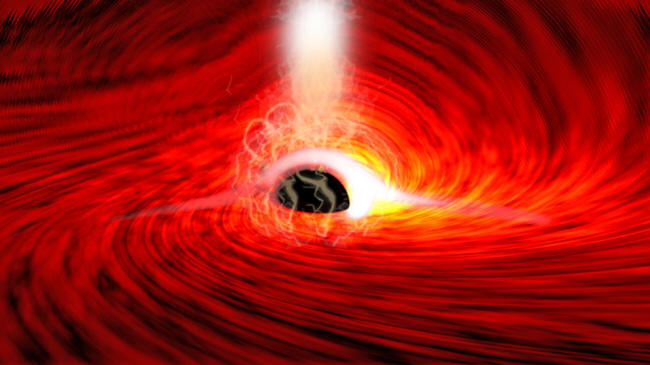|

by Andrew Griffin
July 28,
2021
from
MSN Website

© Dan Wilkins
Scientists see light
from the other
side of a Black Hole
for the first
ever time...
Such an observation might seem not just difficult but outright
impossible, given black holes famously eat up any light that goes
near them.
But the new study used an unusual effect where light "echoes" around
the Black Hole, such that scientists can see it from the other side.
The detection came after scientists examined X-rays that were being
thrown out into the universe by a supermassive
Black Hole that sits
in the middle of another galaxy, 800 million light years away.
Those X-rays kept to a strange pattern:
after the bright,
flaring X-rays, there would be smaller and later ones, which
appeared in different "colors" than those more obvious ones.
The X-rays looked as if
they were being reflected from the other side of the Black Hole,
noticed Stanford University astrophysicist
Dan Wilkins.
But such an event would
seem highly unusual, given black holes are more famous for
destroying light than being a source of it.
"Any light that goes
into that Black Hole doesn't come out, so we shouldn't be able
to see anything that's behind the Black Hole," he said in a
statement.
What
if you could see through a Black Hole?
But it was another, less
famous characteristic of black holes that meant those X-rays could
be seen.
"The reason we can
see that is because that Black Holes is warping space, bending
light and twisting magnetic fields around itself," Wilkins
explained.
The discovery of light
from the other side of a Black Hole was predicted by Einstein's
theory of general relativity.
But it has never actually
happened before, and the discovery marks the first time that,
light
has ever been directly observed coming from behind a Black Hole...
The research began with a slightly different aim of a more common
light formed by a Black Hole:
the corona which
wraps around the outside of it, formed as material falls in.
That corona is among the
brightest continuous sources in the universe, flinging out X-ray
light that can be then be used to analyze the Black Hole itself.
Researchers think that the corona starts when gas falls into the
Black Hole and is heated up to a temperature of millions of degrees.
It is so hot that the
electrons are ripped from the atoms, and it forms huge arcing and
twirling magnetic fields that break apart.
"This magnetic field
getting tied up and then snapping close to the Black Hole heats
everything around it and produces these high energy electrons
that then go on to produce the X-rays," said Wilkins.
But it was those smaller
flashes that surprised him - and went on to produce the newly
announced research, as well as the first ever glimpse at the other
side of a Black Hole.
"I've been building
theoretical predictions of how these echoes appear to us for a
few years," said Wilkins.
"I'd already seen
them in the theory I've been developing, so once I saw them in
the telescope observations, I could figure out the connection."
The study, 'Light
Bending
and X-ray Echoes from behind a Supermassive Black Hole', is
published in Nature today.
|


